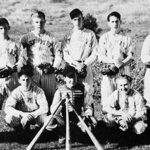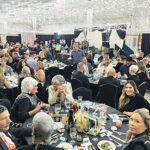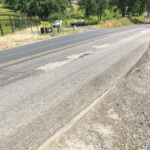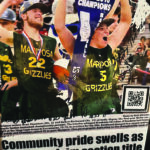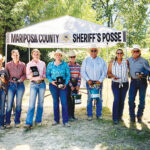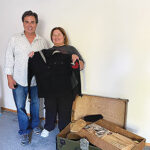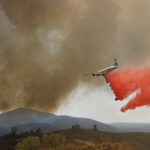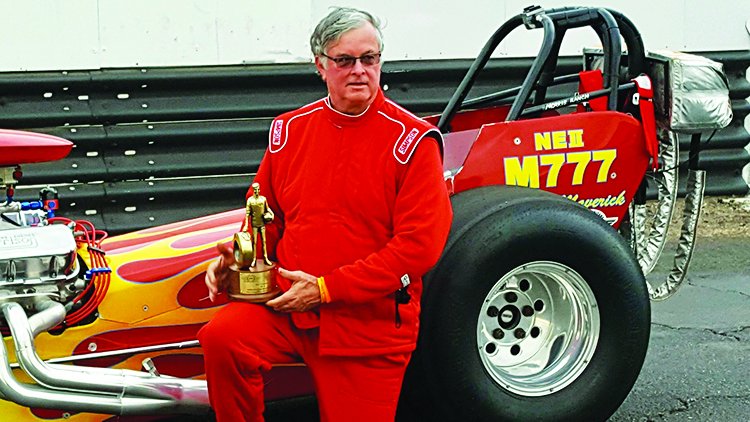
Drag racing duo burns tracks in the record book
It’s a memorable scene when Maverick and his sidekick Goose are confidently striding across the tarmac in their olive flight suits and Maverick says, “I feel the need,” and they announce in unison, “the need for speed.” That unforgettable moment was captured in the 1986 blockbuster movie, Top Gun.
Two local speed disciples who began their adventures on the drag strip years before the advent of the Top Gun movie have made their mark on the sport that draws hundreds of thousands of enthusiasts to the track every year.
Dave Lawson, who owns and operates Lawson Construction in Mariposa, and George Thomas, the owner of Mariposa Auto Body, affectionately known as “T-Bone” on the track, have been competing in different drag race classifications for years – very successfully.
Lawson followed in the tracks of Mariposa’s first drag racing team, Gary, and Bill Williams, who were dominant in the sport during the 1960s. Lawson says he believes Gary Williams established over 18 world records.
The contractor turned drag racer arrived in Mariposa in 1962, in the third grade. He was born in Vienna, Austria and graduated from Mariposa County High School in 1972.
Lawson started going to drag races with the Williams brothers while he was in high school. “I never really thought I would be a dragster pilot, but I found I really liked it,” Lawson explained. His first car was a 1956 Chevrolet “Handyman” station wagon that he purchased in Hornitos for $150. That car is still part of the Lawson Racing stable today. He built that car up in auto shop at the local high school.
He first put his pedal to the metal at Famoso Drag Strip in Bakersfield at the age of 19 in what is known as a “door slammer” race car. (Any vehicle in drag races that has a door that opens and closes is known as a “door slammer.”) That was his first step toward quenching his “need for speed.”
It took years and years of races and different dragsters in different classes before Lawson landed his first national championship and the coveted “Wally” Award.
The Wally Trophy is drag racing’s most prestigious award. According to the National Hot Rod Association (NHRA) website, “At just more than one-foot tall with a classy brass finish, he stands on a solid wooden platform and is the most sought-after man in the world of NHRA Camping World Drag Racing. Be warned: he is elusive. Only the best can catch him. Affectionately known as a “Wally” in honor of the late NHRA founder Wally Parks by the thousands of NHRA competitors who seek it, the trophy has taken on a life of its own, and remains one of the single biggest motivators for high-performance enthusiasts from the smallest one-car garage in Kennebunkport, Maine, to one of the sport’s most sophisticated centers of technology and engineering in Yorba Linda, CA.”
Lawson won his first national title in 2016. The 2016 trophy was in the American National Racing Association (ANRA), which he won again in 2020. Interspersed between those crowns were championships from the National Hot Rod Association in 2017, 2019, and 2021.
National titles are earned through a combination of race finishes and competition points that are accumulated throughout the season.
Most recently, Lawson has been racing in a 2025-inch front engine dragster, commonly known as a “rail” or “digger.” With Lawson at the wheel, that dragster can go from zero to 100 miles per hour in less than two seconds. It’s powered by a 1,000 horsepower 562-cubic inch big block Chevy engine.
He can run around 180 miles per hour in the quarter mile and stops with the assistance of a parachute. The parachute is not only to bring the dragster to a stop, but also to straighten out its path on the track as it slows.
Now at age 70, Lawson says he’ll be back on the track next season, but he’ll be racing the Chevy wagon. “At my age, at 190 miles per hour, maybe I’m pushing it a little bit,” Lawson said.
The highlights of his career have been winning the Wally Awards, and the three years he got to spend on the road with his daughter, Kim, who dipped her toe into the drag racing world at the tender age of 16 when she was in high school. “Doing all the traveling with Kim and spending that time with her was a blessing,” Lawson said.
The other half of the high-speed tandem, Thomas, became involved in 1993 when he moved to Mariposa full time. He moved his family here in 1989. “I was looking for a school district to put my kids in, something that wasn’t full of (expletive deleted),” Thomas explained.
He commuted from San Jose where he operated an auto body shop for four years and did restoration work for some professional baseball greats, including Reggie Jackson, before making the permanent change and opening the doors of Mariposa Auto Body.
Thomas says he got interested in drag racing in high school when he was 17. He street raced a 1963 Plymouth Fury. “My wife and I dated at the Fremont Raceway. We met in high school, but we dated at the track. Instead of going to dinner or the movies, we went to the track,” Thomas said.
“Dave and I met about 33 years ago and talked a lot about racing stuff. He had taken a break and didn’t get back into racing until his daughter, Kim, started racing,” Thomas added. Kim was racing her high school car, an AMC Javelin. That’s when he joined the team as the crew chief for the dragster and went on to pilot the Chevy wagon and Javelin under the Red Hot Lawson Racing, Inc. flag.
Thomas’ first race was in 1973 or 1974 as he recalls. He raced his Fury at Fremont Raceway. He was hooked.
His first win on the track was seven years ago in Bakersfield in the Javelin. Thomas accomplished a feat that is almost unheard of, a “trip zip.” That describes the amount of time measured from when the light flashes green at the starting stripe and the driver releases the button that throws all the torque into the drivetrain. “You’ve already got the pedal to the floor when you release the button. To win your first race with a ‘trip zip’ is unheard of,” Thomas recounted.
“This was all under the Lawson Racing umbrella,” Thomas explained. “I was driving Dave’s car, but it was basically a partnership. He was my mentor. His knowledge of being able to cut a light and his years in the trenches were my guiding light. But by the same token, we have done a lot together to get the championships.”
“It’s all about the comradery at the track too,” Thomas added. “Hanging out with your fellow racers is really special.”
Just a few weeks ago, Thomas had an experience that anyone would consider more than a close call. He described the ride in the Chevy wagon. “I launched the car; I released the button; it’s a trans brake and I already had the pedal mashed to the floor. The car lifted straight up, and I shifted into second. Everything was fine. I shifted into third at 1,000 feet and it blew the tranny. There was lots of flame blowing straight over the hood and windshield. The motor lunged forward when the tranny blew, and it hit the radiator. The radiator exploded, fortunately, and put the fire out.”
“Even though it blew up, I ran a 10.42 at 119 miles per hour,” Thomas boasted. The Chevy wagon runs an 825-horsepower engine.
Thomas explained that when he blew up the tranny, two fellow racers came up and volunteered to let him drive their cars since he was running second in points. “One of the guys that offered me his car was fourth in points. I turned him down, and he eventually won it. That’s the comradery at the track,” he said.
The two will start another campaign on the track this season and more trophies and recognition could be in the offing.
Thomas was asked if there’s any money to be made in drag racing. “There’s a small fortune to be made in drag racing, if you start with a big one,” he answered.







